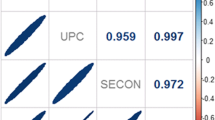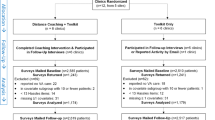ABSTRACT
BACKGROUND
Coordination across a patient’s health needs and providers is important to improving the quality of care.
OBJECTIVES
(1) Describe the extent to which adults report that their care is coordinated between their primary care physician (PCP) and specialists and (2) determine whether visit continuity with one’s PCP and the PCP as the referral source for specialist visits are associated with higher coordination ratings.
DESIGN
Cross-sectional study of the 2007 Health Tracking Household Survey.
PARTICIPANTS
A total of 3,436 adults with a PCP and one or more visits to a specialist in the past 12 months.
MEASUREMENTS
Coordination measures were patient perceptions of (1) how informed and up to date the PCP was about specialist care received, (2) whether the PCP talked with the patient about what happened at the recent specialist visit and (3) how well different doctors caring for a patient’s chronic condition work together to manage that care.
RESULTS
Less than half of respondents (46%) reported that their PCP always seemed informed about specialist care received. Visit continuity with the PCP was associated with better coordination of specialist care. For example, 62% of patients who usually see the same PCP reported that their PCP discussed with them what happened at their recent specialist visit vs. 48% of those who do not usually see the same PCP (adjusted percentages, p < 0.0001). When a patient’s recent specialist visit was based on PCP referral (vs. self-referral or some other source), 50% reported that the PCP was informed and up to date about specialist care received (vs. 35%, p < 0.0001), and 66% reported that their PCP discussed with them what happened at their recent specialist visit (vs. 47%, p < 0.0001).
CONCLUSIONS
Facilitating visit continuity between the patient and PCP, and encouraging the use of the PCP as the referral source would likely enhance care coordination.

Similar content being viewed by others
REFERENCES
Starfield B. Primary care: Balancing health needs, services and technology. New York: Oxford University Press; 1998:438.
McDonald KM, Sundaram V, Bravata DM, et al. Care Coordination. Vol 7 of: Shojania KG, McDonald KM, Wachter RM, Owens DK, editors. Closing the Quality Gap: A Critical Analysis of Quality Improvement Strategies. Technical review No. 9 (Prepared by the Stanford University-UCSF Evidence-based Practice Center under contract 290-02-0017). AHRQ Publication No. 04(07)-0051-7. Rockville, MD: Agency for Healthcare Research and Quality. June 2007.
Institute of Medicine. Primary Care: America’s Health in a New Era. 1996. National Academy Press, Washington D.C., 395 pp.
Laine C, Davidoff F, Lewis CE, et al. Important elements of outpatient care: a comparison of patients’ and physicians’ opinions. Ann Intern Med. 1996;125:640–5.
Anderson R, Barbara A, Feldman S. What patients want: A content analysis of key qualities that influence patient satisfaction. J Med Pract Manage. 2007;22(5):255–61.
Stille CJ, Jerant A, Bell D, Meltzer D, Elmore JG. Coordinating care across diseases, settings and clinicians: a key role for generalist in practice. Ann Intern Med. 2005;142:700–8.
Forrest CB, Glade GB, Baker AE, Bocian A, von Schrader S, Starfield B. Coordination of specialty referrals and physician satisfaction with referral care. Arch Pediatr Adolesc Med. 2000;154:499–506.
Bodenheimer T, Lo B, Casalino L. Primary care physicians should be coordinators, not gatekeepers. JAMA. 1999;281:2045–9.
Parchman ML, Noël PH, Lee S. 2005 Primary care attributes, health care system hassles, and chronic illness. Med Care. 2005;11:1123–9.
Safran DG, Tarlov AR, Rogers WH. Primary care performance in fee-for-service and prepaid health care systems. Results from the medical outcomes study. JAMA. 1994;271:1579–86.
Cummins RO, Smith RW, Inui TS. Communication failure in primary care, Failure of consultants to provide follow-up information. JAMA. 1980;243:1650–2.
Schoen C, Osborn R, Doty MM, Bishop M, Peugh J, Murukutia N. Toward higher-performance health systems: adults’ health care experiences in seven countries, 2007. Health Aff (Millwood). 2007; Nov-Dec: w717-34.
Audet AM, Davis K, Schoenbaum SC. Adoption of Patient-Centered Care Practices by Physicians. Arch Intern Med. 2006;166:754–9.
Medicare Payment Advisory Commission (MedPAC) Report to Congress. Increasing the Value of Medicare. Chapter 2, “Care Coordination in Fee-for service Medicare,” June 2006:31-56.
http://www.hschange.org/CONTENT/757/757.pdf; Household Survey Methodology report Round 4 (2007), and the Round 5 (2008). Accessed November 18, 2008.
Johnson DR, Addressing the Growing Problem of Survey Nonresponse. http://www.ssri.psu.edu/survey/Nonresponse1.ppt. Accessed November 18, 2008.
Carlson BL, Strouse R. The Value of the Increasing Effort to Maintain High Response Rates in Telephone Surveys. In American Statistical Association, 2005 Proceedings of the Section on Survey Research Methods. Alexandria, VA: American Statistical Association; 2005 August.
National Health Interview Survey, NHIS. http://www.cdc.gov/nchs/about/major/nhis/hisdesc.htm. Accessed June 11, 2008.
CAHPS Clinician and Group Adult Survey. http://www.qualitymeasures.ahrq.gov/Browse/DisplayOrganization.aspx?org_id = 9&doc = 746. Accessed June 11, 2008.
Adult Primary Care Assessment Tool, Starfield B. Johns Hopkins University 1998; http://www.jhsph.edu/hao/pcpc/tools.htm, last accessed June 11, 2008.
Safran DG, Kosinski M, Tarlov AR, et al. The Primary Care Assessment Survey: tests of data quality and measurement performance. Med Care. 1998;36(5):728–39 May.
Haggerty JL, Pineault R, Beaulieu M, et al. Practice features associated with patient-reported accessibility, continuity, and coordination of primary health care. Ann Fam Med. 2008;6:116–23.
Hibbard JH, Stockard J, Mahoney ER, Tusler M. Development of the Patient Activation Measure (PAM): Conceptualizing and Measuring Activation in Patients and Consumers. Health Serv Res. 2004;39:1005–26.
Research Triangle Institute. SUDAAN Language Manual, Release 9.0.1. Research Triangle Park, NC: Research Triangle Institute; 2005.
Christakis DA, Wright JA, Zimmerman FJ, Bassett AL, Connell FA. Continuity of care is associated with well-coordinated care. Ambul Pediatr. 2003;3:82–6.
Forrest CB, Weiner JP, Fowles J, et al. Self-referral in point-of-service health plans. JAMA. 2001;285:2223–31.
Shea D, Stuart B, Vasey J, Nag S. Medicare physician referral patterns. Health Serv Res. 1999;34:331–48.
Fisher ES, Wennberg DE, Stukel TA, Gottlieb DJ, Lucas FL, Pinder EL. The implications of regional variations in Medicare spending. Part 1: the content, quality, and accessibility of care. Ann Intern Med. 2003;138:273–87.
Wolinsky FD, et al. Hospital episodes and physician visits: the concordance between self-reports and Medicare claims. Med Care. 2007;45:300–7.
Grumbach K, Selby JV, Damberg C, et al. Resolving the gatekeeper conundrum what patients value in primary and referrals to specialists. JAMA. 1999;282:261–6.
Acknowledgement
This study and the 2007 Health Tracking Household Survey were funded entirely by the Robert Wood Johnson Foundation. We also thank the anonymous reviewers for their feedback on an earlier version of the manuscript.
Conflict of Interest
None disclosed.
Author information
Authors and Affiliations
Corresponding author
Rights and permissions
About this article
Cite this article
O’Malley, A.S., Cunningham, P.J. Patient Experiences with Coordination of Care: The Benefit of Continuity and Primary Care Physician as Referral Source. J GEN INTERN MED 24, 170–177 (2009). https://doi.org/10.1007/s11606-008-0885-5
Received:
Revised:
Accepted:
Published:
Issue Date:
DOI: https://doi.org/10.1007/s11606-008-0885-5




